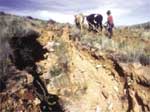



Scientifically robust and consistent baseline information about the extent of land degradation is important when it comes to identifying priorities and monitoring the consequences of actions.
Previous assessments of the global extent of land degradation provided different figures and, in general, suffered from shortcomings linked to the information sources used. There is a need for a systematic global assessment and monitoring program, leading to the development of a scientifically credible, consistent baseline of the state of desertification.
Drylands lend themselves readily to remote sensing because they are mostly cloud-free. Continuity of observations is required to account for the high year-to-year variability of dryland ecosystem conditions. Combining the use of satellite-based remote sensing or aerial photographs with ground-based observations can provide consistent, repeatable, cost-effective data on vegetation cover. Access to affordable satellite imagery is thus critical, particularly in developing countries.
Both human actions and climate variability influence vegetation and its growth. Long-term monitoring is needed to distinguish between these two influences. Quantifying such impacts requires an established baseline against which changes can be assessed. But this comparison is complicated by year-to-year and even decade-to-decade fluctuations.
In order to better understand the impacts of desertification on human well-being we need to improve our knowledge of the interactions between socioeconomic factors and ecosystem conditions. These interactions are most easily analyzed at a local scale, where linkages can be most clearly identified. Therefore, information about socioeconomic factors related to desertification needs to be gathered at sub-national levels. More...
Changes in ecosystems can be gradual until a certain threshold is reached, at which point abrupt or irreversible changes can occur. Uncertainties about the way biological, physical, social, and economic factors interact limit our ability to detect such thresholds in drylands and to assess the actual effect of policies on desertification.
The impact of poverty reduction strategies on ecosystem services and desertification has not yet been fully explored by governments and the international community. To be successful in combating desertification, policies should include broader notions of poverty and should take into account the role of ecosystem services in poverty reduction programs.
The contribution of cities located in drylands to desertification is not clear. It is not known to which degree they may contribute to desertification (through the overexploitation of dryland ecosystem services) or relieve some of the pressures on desertified areas (through economic opportunities). More...

This summary is free and ad-free, as is all of our content. You can help us remain free and independant as well as to develop new ways to communicate science by becoming a Patron!